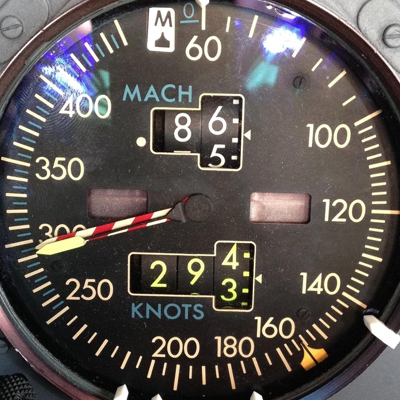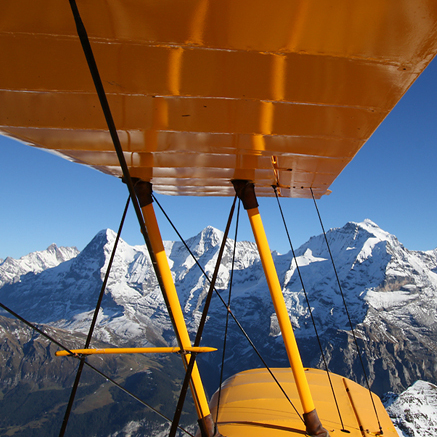Moderators: richierich, ua900, PanAm_DC10, hOMSaR
-

- aviator001
- Posts: 7
- Joined:
How Temperature affects flight level
My Question is how non standard temperature affect flight levels ( above 18000 feet ) ??
For example if two airplanes are flying 100 mile apart each other, each airplane sets it's altimeter to the standard of 1013.2 or 29.92 and flying at FL360, so theoretically both of them are flying at the same altitude, now if there is a difference between the temperature for the two airplane ( for example one is ISA+10 and the other is ISA-10 ), are they still flying at the same altitude in relation to each other ?
For example if two airplanes are flying 100 mile apart each other, each airplane sets it's altimeter to the standard of 1013.2 or 29.92 and flying at FL360, so theoretically both of them are flying at the same altitude, now if there is a difference between the temperature for the two airplane ( for example one is ISA+10 and the other is ISA-10 ), are they still flying at the same altitude in relation to each other ?
-

- RetiredWeasel
- Posts: 942
- Joined:
Re: How Temperature affects flight level
Setting 29.92 and flying a constant indicated altitude means you are flying a constant pressure level. So you would be following a vertical isobar. The true altitude of a vertical isobar changes with distance due to low pressure areas, high pressure areas and I'm sure temperature affects/changes the true altitude of that isobar but it's not the sole factor. Two aircraft 100 miles apart are probably not at exactly at the same true altitude, but they could be. That's just my two cents.
-

- Starlionblue
- Posts: 21730
- Joined:
Re: How Temperature affects flight level
To start with, two planes on standard QNH in different locations are not theoretically flying at the same real altitude. As RetiredWeasel says, they are following a vertical isobar (a layer of equal pressure). Their altimeters are set to standard but the local QNH is unlikely to be exactly standard. If the actual QNH is lower than standard, a plane will be higher than the altimeter reading. and vice versa.
Temperature also affects real altitude. A higher temperature means the column of air is taller. Assuming the QNH is exactly equal for our two aircraft, the one flying in higher temperature air will be higher.
Temperature also affects real altitude. A higher temperature means the column of air is taller. Assuming the QNH is exactly equal for our two aircraft, the one flying in higher temperature air will be higher.
-

- Starlionblue
- Posts: 21730
- Joined:
Re: How Temperature affects flight level
Starlionblue wrote:To start with, two planes on standard QNH in different locations are not theoretically flying at the same real altitude. As RetiredWeasel says, they are following a vertical isobar (a layer of equal pressure). Their altimeters are set to standard but the local QNH is unlikely to be exactly standard. If the actual QNH is lower than standard, a plane will be higher than the altimeter reading. and vice versa.
Temperature also affects real altitude. A higher temperature means the column of air is taller. Assuming the QNH is exactly equal for our two aircraft, the one flying in higher temperature air will be higher.
Or I might just have woken up and am not accurately remembering basic theory. The world is so fuzzy before my first cup of coffee... #makingexcuses
-

- Florianopolis
- Posts: 382
- Joined:
Re: How Temperature affects flight level
Starlionblue wrote:Or I might just have woken up and am not accurately remembering basic theory. The world is so fuzzy before my first cup of coffee... #makingexcuses
Don't worry. The quickest way to get a correct answer around here is to post an incorrect answer first.
-

- Starlionblue
- Posts: 21730
- Joined:
Re: How Temperature affects flight level
Florianopolis wrote:Starlionblue wrote:Or I might just have woken up and am not accurately remembering basic theory. The world is so fuzzy before my first cup of coffee... #makingexcuses
Don't worry. The quickest way to get a correct answer around here is to post an incorrect answer first.
Challenge accepted...
-

- aviator001
- Posts: 7
- Joined:
Re: How Temperature affects flight level
Starlionblue wrote:To start with, two planes on standard QNH in different locations are not theoretically flying at the same real altitude. As RetiredWeasel says, they are following a vertical isobar (a layer of equal pressure). Their altimeters are set to standard but the local QNH is unlikely to be exactly standard. If the actual QNH is lower than standard, a plane will be higher than the altimeter reading. and vice versa.
Temperature also affects real altitude. A higher temperature means the column of air is taller. Assuming the QNH is exactly equal for our two aircraft, the one flying in higher temperature air will be higher.
Thank you for your answer, but as far as i understand when the QNH is lower than standard the airplane will be lower in terms of true altitude ( real altitude above mean sea level ), pressure altitude more than true altitude above MSL
and about the temperature section, i didn't really get it,so does the temperature affects the vertical distance of the pressure altitude ?
-

- aviator001
- Posts: 7
- Joined:
Re: How Temperature affects flight level
aviator001 wrote:Starlionblue wrote:To start with, two planes on standard QNH in different locations are not theoretically flying at the same real altitude. As RetiredWeasel says, they are following a vertical isobar (a layer of equal pressure). Their altimeters are set to standard but the local QNH is unlikely to be exactly standard. If the actual QNH is lower than standard, a plane will be higher than the altimeter reading. and vice versa.
Temperature also affects real altitude. A higher temperature means the column of air is taller. Assuming the QNH is exactly equal for our two aircraft, the one flying in higher temperature air will be higher.
Thank you for your answer, but as far as i understand when the QNH is lower than standard the airplane will be lower in terms of true altitude ( real altitude above mean sea level ), pressure altitude more than true altitude above MSL
and about the temperature section, i didn't really get it,so does the temperature affects the vertical distance of the pressure altitude ?
https://www.photobox.co.uk/my/photo/ful ... 0656563936
Re: How Temperature affects flight level
Florianopolis wrote:Starlionblue wrote:Or I might just have woken up and am not accurately remembering basic theory. The world is so fuzzy before my first cup of coffee... #makingexcuses
Don't worry. The quickest way to get a correct answer around here is to post an incorrect answer first.
Now that's funny!
Re: How Temperature affects flight level
aviator001 wrote:and about the temperature section, i didn't really get it,so does the temperature affects the vertical distance of the pressure altitude ?
Colder air is more dense. Therefore the true altitude difference between pressure levels shrinks. As a rule of thumb it is 4% per 10°K difference from standard.
As an example:
In the standard atmosphere at 0 ft the pressure is 1013.2 hPa. At 10000 ft the pressure is 696 hPa.
With air colder than standard this two pressure levels will come closer together. So if for example the average temperature is 10° below standard the true alttitude between the two levels will shrink by 4% - 400 ft in this case. That means the true altitude of an aircraft in an atmosphere 10° below standard is 9600 ft, while the indicated altitude will still be 10000 ft (the altimeter still sensing a pressure of 696 hPa).
(Assuming standard pressure for the above example).
Re: How Temperature affects flight level
glen wrote:aviator001 wrote:and about the temperature section, i didn't really get it,so does the temperature affects the vertical distance of the pressure altitude ?
Colder air is more dense. Therefore the true altitude difference between pressure levels shrinks. As a rule of thumb it is 4% per 10°K difference from standard.
As an example:
In the standard atmosphere at 0 ft the pressure is 1013.2 hPa. At 10000 ft the pressure is 696 hPa.
With air colder than standard this two pressure levels will come closer together. So if for example the average temperature is 10° below standard the true alttitude between the two levels will shrink by 4% - 400 ft in this case. That means the true altitude of an aircraft in an atmosphere 10° below standard is 9600 ft, while the indicated altitude will still be 10000 ft (the altimeter still sensing a pressure of 696 hPa).
(Assuming standard pressure for the above example).
Excellent brief explanation. Have an "upvote"
The 4% per 10 Kelvin is the rule which is also taught in flight school.
Comes handy especially in "cold weather ops", when flying VFR. There are numerous test questions on the ATPL exam which handle the subject and require some amount of calculation.
I.E.; if you're at FL130 at ISA-15, what is the highest altitude a mountain can have so that you are able to clear it by a vertical distance of at least 1500ft, or so.
Who is online
Users browsing this forum: No registered users and 33 guests


